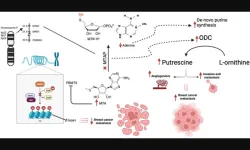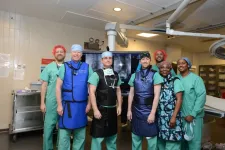(Press-News.org) UNIVERSITY PARK, Pa. — In 2002, an area of ice about the size of Rhode Island dramatically broke away from Antarctica as the Larsen B ice shelf collapsed. A new study of the conditions that led to the collapse may reveal warning signs to watch for future Antarctic ice shelf retreat, according to a Penn State-led team of scientists.
“The collapse of the Larsen B ice shelf is generally thought of as an independent event,” said Shujie Wang, assistant professor of geography at Penn State. “Our work shows that it was the last phase in a calving sequence that began in 1998 and was controlled by both atmospheric and oceanic warming anomalies that weakened the ice shelf structure over time.”
Ice shelves are floating tongues of ice connected to land but extend out and float on ocean water. Scientists have long known that warming air and ocean temperatures melt and weaken ice shelves from the surface and the subsurface, but the exact processes leading to collapse are not well understood.
And because ice shelves act as a buttress, holding back glaciers on land flowing toward the ocean, understanding how they will react to continued warming is important for getting sea-level rise predictions right, the scientists said.
“Ice-shelf loss from environmental warming is the fastest way for Antarctica to drive sea-level rise, but remains very hard to predict in part because we have so few observations,” said Richard Alley, Evan Pugh University Professor of Geosciences at Penn State and a co-author on the study. “The Larsen B ice shelf was not holding back much land ice, and so its loss was not very important for sea level, but it offers an outstanding laboratory to learn the early warning signs and the processes of ice-shelf loss. The new insights gained here should help in the larger effort to project how warming will interact with the ice shelves to control future contributions to sea-level rise.”
The scientists gathered data on the ice shelf from as far back as the 1960s and analyzed changes over time using satellite observations, modeling experiments and climate reanalysis data.
Prior to the 2002 collapse, the ice shelf experienced a transition from typical large calving events — when chunks of ice break off into the ocean — to more frequent, smaller calving and to a faster, widespread flow of ice toward the sea.
“Typically, large chunks of ice break off, regrow for decades and break off again,” said Wang, lead author on the study and an associate of the Earth and Environmental Systems Institute and Institute for Computational and Data Sciences at Penn State. “Here, many smaller calving events occurred, and the ice did not regrow. And when it retreated from rocky islands that served as a buttress for the ice shelf, that could no longer hold the flow back.”
The findings suggest that widespread flow acceleration and frequent small-iceberg calving may serve as quantifiable precursors for ice-shelf destabilization, the scientists reported in the journal Earth and Planetary Letters.
Five calving pulses observed between 1998 to 2002 corresponded with climate anomalies caused by La Niña and the Southern Annular Mode, characterized by strong westerly winds in the Southern hemisphere moving closer to Antarctica.
Warmer ocean waters may have cut sub-ice-shelf channels, further weakening vulnerable parts of the ice shelf called shear margins. These margins separate flowing ice from stagnant ice or rock, and the areas often have more fractures and softer ice, the scientists said.
“The results suggest that warm climate anomalies control the occurrence of calving, while the extent and speed of calving are governed by ice shelf geometry and mechanical conditions, in particular, the sturdiness of the weakest shear margin,” Wang said.
Failure of a shear margin in the northern portion of the ice sheet may have triggered the calving pulses, and as the ice retreated, it moved away from rocky islands that had served as buttresses holding the sheet in place, the scientists said.
“When you pin a piece of paper to a wall, the pins prevent the paper from falling to the floor,” Wang said. “It’s the same with ice flow — these rocky islands serve as ‘pinning points’ that anchor ice and slow down its march to the sea.”
The distribution of these pinning points may help determine the vulnerability of an ice sheet, as a weak shear margin with limited buttressing sources played a predominant role in destabilizing the Larsen B ice shelf and starting the small-iceberg calving sequence, the scientists reported.
“Those smaller areas matter for the whole region,” Wang said. “If you think about an ice shelf as a complex system, local areas may have a dominant impact on the whole ice shelf. These fundamentals are important because if we don’t understand the fundamentals, we can’t make the most accurate predictions for the future.”
Also contributing to this study were Zhengrui Huang, doctoral student in geography at Penn State, Hongxing Liu, professor at the University of Alabama, Kenneth Jezek, professor emeritus at Ohio State University, Patrick Alexander, associate research scientist at Lamont-Doherty Earth Observatory, Columbia University, Karen Alley, assistant professor at the University of Manitoba, and Lei Wang, professor at Louisiana State University.
NASA, the National Science Foundation, the Heising-Simons Foundation and the Natural Sciences and Engineering Research Council provided support for this work.
END
New study finds early warning signs prior to 2002 Antarctic ice shelf collapse
Indicators could be used to watch for future Antarctic ice shelf collapse, according to scientists
2023-03-14
ELSE PRESS RELEASES FROM THIS DATE:
Oncotarget | MTAP loss in metastatic breast cancer patients: Genomic landscape
2023-03-14
“In breast cancer, MTAP downregulation activates ornithine decarboxylase (ODC) which in turn leads to formation of putrescine which promotes tumor migration, invasion and angiogenesis [15].”
BUFFALO, NY- March 14, 2023 – A new research paper was published in Oncotarget's Volume 14 on March 11, 2023, entitled, “Genomic landscape of metastatic breast cancer (MBC) patients with methylthioadenosine phosphorylase (MTAP) loss.”
Homozygous deletion of methylthioadenosine phosphorylase (MTAP) upregulates de novo synthesis ...
Tim Michalski selected as Jefferson Lab’s engineering manager
2023-03-14
NEWPORT NEWS, VA – The U.S. Department of Energy’s (DOE) Thomas Jefferson National Accelerator Facility has selected Tim Michalski to lead its Engineering Division as the Engineering Division Manager. In this role, Michalski oversees all aspects of the management and operation of the Engineering Division. The division includes more than 200 staff members and supports the Continuous Electron Beam Accelerator Facility and the lab’s growing project portfolio.
“I am proud to name Tim as our newest Engineering Division Manager,” said Jefferson Lab Director Stuart Henderson. “Tim has ...
Princeton Chem, IAS uncover spatial patterns in distribution of galaxies
2023-03-14
In late 2021, Salvatore Torquato, on sabbatical from Princeton’s Department of Chemistry, reached across the aisle as it were and invited a young astrophysicist at the Institute for Advanced Study to apply the tools of statistical mechanics to his own work on the distribution of galaxies.
The astrophysicist, Oliver Philcox, now a postdoc at the Simons Foundation, was intrigued. A year-long collaboration ensued.
The questions at the heart of their unusual partnership were straightforward: can the statistical descriptors Torquato has worked with throughout his career find application in unlikely places like cosmology, and can they accurately characterize the complexity in the distribution ...
Researchers look to AI for decision-making in extreme situations
2023-03-14
Imagine you are a doctor managing the emergency room of a large hospital. You suddenly get a call reporting a mass shooting at a nearby concert. In 20 minutes, you will be responsible for triaging more than 200 patients with a range of injuries. You do not have enough staff or resources and the hospital policies are not designed for a situation this dire.
“When people respond to emergencies, many decisions they face are quite predictable. They’re trained on them, and there’s policy,” said UMass Lowell’s Neil Shortland, associate professor in the School of Criminology and Justice Studies. “But every now and then, they get stuck with a really ...
Mix-and-match kit could enable astronauts to build a menagerie of lunar exploration bots
2023-03-14
When astronauts begin to build a permanent base on the moon, as NASA plans to do in the coming years, they’ll need help. Robots could potentially do the heavy lifting by laying cables, deploying solar panels, erecting communications towers, and building habitats. But if each robot is designed for a specific action or task, a moon base could become overrun by a zoo of machines, each with its own unique parts and protocols.
To avoid a bottleneck of bots, a team of MIT engineers is designing a kit of universal ...
Common dry cleaning chemical linked to Parkinson’s
2023-03-14
A common and widely used chemical may be fueling the rise of the world’s fastest growing brain condition – Parkinson’s disease. For the past 100 years, trichloroethylene (TCE) has been used to decaffeinate coffee, degrease metal, and dry clean clothes. It contaminates the Marine Corps base Camp Lejeune, 15 toxic Superfund sites in Silicon Valley, and up to one-third of groundwater in the U.S. TCE causes cancer, is linked to miscarriages and congenital heart disease, and is associated ...
Molecular component of caffeine may play a role in gut health
2023-03-14
Brigham researchers studying how and why certain cell types proliferate in the gut found that xanthine, which is found in coffee, tea and chocolate, may play a role in Th17 differentiation
Insights may help investigators better understand gut health and the development of conditions such as inflammatory bowel disease
The gut is home to a cast of microbes that influence health and disease. Some types of microorganisms are thought to contribute to the development of inflammatory conditions, such as inflammatory bowel disease (IBD), but the exact cascade of events that leads from microbes to immune cells to disease remains ...
Ochsner Health announces new Aortic Center; subscribes to cutting-edge imaging with Cydar Technology
2023-03-14
NEW ORLEANS, La. – Global death rates from aortic diseases have steadily increased over the past two decades. Studies show up to 8% of individuals will develop an aortic aneurysm during their lifetime, higher than rates of colon and lung cancer combined, and over 80% of ruptured aortic aneurysms cause sudden death.
To save lives and improve outcomes for patients with aortic disease of all kinds, Ochsner Health is excited to announce the establishment of The Ochsner Aortic Center. Outfitted with cutting-edge imaging technology that allows medical staff to make faster, easier, and safer decisions, this dedicated, comprehensive aortic center is now the ...
Aston Pharmacy School researchers develop new technique mixing oil and water to improve drug delivery
2023-03-14
A team of researchers from Aston University has developed a new technique that could be a game changer for the medical and drinks industries.
The technology enables insoluble drug/oil to be dissolved in water. The technique is novel because it doesn’t just mix the two together to make an emulsion, it makes oil soluble in water and has the potential to revolutionise a variety of medical treatments and improve drug delivery.
The technique was developed with Max Bio+ a spin out company founded by Professor Sunil Shah, a consultant ...
New guideline introduces recommendations for optimal timing of elective hip or knee arthroplasty
2023-03-14
ATLANTA — The American College of Rheumatology (ACR) and the American Association of Hip and Knee Surgeons (AAHKS) released a summary of its new guideline titled “the Optimal Timing of Elective Hip or Knee Arthroplasty for Patients with Symptomatic Moderate to Severe Osteoarthritis or Osteonecrosis Who Have Failed Nonoperative Therapy.” The ACR and AAHKS have worked together before, creating guidelines for Perioperative Management of Antirheumatic Medication in Patients with Rheumatic Diseases Undergoing Elective Total Hip or Total Knee Arthroplasty in 2017 and 2022. While those guidelines focus on which medications ...
LAST 30 PRESS RELEASES:
Smartwatch use enhances the detection of heart arrythmias, increasing the quality of care.
MAN PPK2: A “universal” enzyme for the production of RNA building blocks
Sniffing out the cause of keratoderma-associated foot odor
Tuning color through molecular stacking: A new strategy for smarter pressure sensors
Humans use local dialects to communicate with honeyguides
Theory-breaking extremely fast-growing black hole
ŌURA and National University of Singapore open Joint Lab to advance research in personalized preventive health
Hope for smarter lung cancer care
Singapore scientists discover lung cancer's "bodyguard system" - and how to disarm it
Bacteria use wrapping flagella to tunnel through microscopic passages
New critique prompts correction of high-profile Yellowstone aspen study, highlighting challenges in measuring ecosystem response to wolf reintroduction
Stroke survivors miss critical treatment, face greater disability due to systemic transfer delays
Delayed stroke care linked to increased disability risk
Long term use of anti-acid drugs may not increase stomach cancer risk
Non-monetary 'honor-based' incentives linked to increased blood donations
Natural ovulation as effective as hormones before IVF embryo transfer
Major clinical trial provides definitive evidence of impacts of steroid treatment on severe brain infection
Low vitamin D levels shown to raise risk of hospitalization with potentially fatal respiratory tract infections by 33%
Diagnoses of major conditions failing to recover since the pandemic
Scientists solve 66 million-year-old mystery of how Earth’s greenhouse age ended
Red light therapy shows promise for protecting football players’ brains
Trees — not grass and other greenery — associated with lower heart disease risk in cities
Chemical Insights scientist receives Achievement Award from the Society of Toxicology
Breakthrough organic crystalline material repairs itself in extreme cold temperatures, unlocking new possibilities for space and deep-sea technologies
Scientists discover novel immune ‘traffic controller’ hijacked by virus
When tropical oceans were oxygen oases
Positive interactions dominate among marine microbes, six-year study reveals
Safeguarding the Winter Olympics-Paralympics against climate change
Most would recommend RSV immunizations for older and pregnant people
Donated blood has a shelf life. A new test tracks how it's aging
[Press-News.org] New study finds early warning signs prior to 2002 Antarctic ice shelf collapseIndicators could be used to watch for future Antarctic ice shelf collapse, according to scientists





